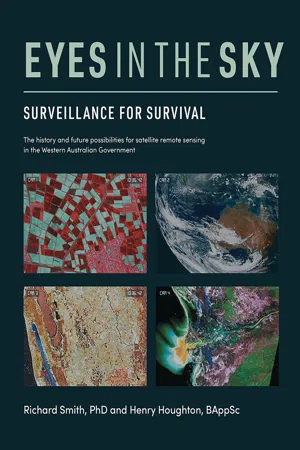Eyes in the Sky
About this book
This book is a must read for anyone concerned with climate change and lack of Government action addressing this rapidly unfolding crisis.
The authors, tell their story of introducing the new technology of observing Earth from Space into the WA Government, following the first images of Earth being sent back by man from space some 50 years ago.
Earth Observing Satellites (EOS) soon followed giving a new and unique view of the Earth revealing the massive human impacts driving climate change, species extinction and human conflicts. For the first time in history key WA Government agencies had unparalleled access to the means of measuring and sustainably managing WA's natural assets across the whole continent and surrounding oceans. Many new and innovative applications of EOS were developed.
Frequently asked questions
- Essential is ideal for learners and professionals who enjoy exploring a wide range of subjects. Access the Essential Library with 800,000+ trusted titles and best-sellers across business, personal growth, and the humanities. Includes unlimited reading time and Standard Read Aloud voice.
- Complete: Perfect for advanced learners and researchers needing full, unrestricted access. Unlock 1.4M+ books across hundreds of subjects, including academic and specialized titles. The Complete Plan also includes advanced features like Premium Read Aloud and Research Assistant.
Please note we cannot support devices running on iOS 13 and Android 7 or earlier. Learn more about using the app.
Information
Table of contents
- Cover
- Title Page
- Copyright
- Dedication
- Acknowledgments
- Contents
- Foreword by Professor Peter Newman
- Foreword by Professor Alexandra Ludewig
- Preface
- Introduction
- Chapter 1. Observing Earth from space – the beginnings
- Chapter 2. Measuring the Earth to manage the future
- Chapter 3. Commonwealth satellite remote sensing initiatives, 1970 – 1989
- Chapter 4. The beginning of WA’s satellite remote sensing 1976 – 1983
- Chapter 5. Establishing WA’s Satellite Remote Sensing Capability 1983 – 1993
- Chapter 6. Recruiting the skills for an Earth Systems Science Centre
- Chapter 7. Oceanographic, geological and agricultural research applications
- Chapter 8. The Leeuwin Centre for Earth Sensing Technologies
- Chapter 9. Products developed for environmental monitoring, 1993 – 2007
- Chapter 10. Satellite remote sensing and climate change
- Chapter 11. Awards won by SRSS, Landgate in The Leeuwin Centre
- Chapter 12. Shutting the gate on the fourth dimension of changes over time
- Chapter 13. Reflections on Landgate’s withdrawal from The Leeuwin Centre
- Chapter 14. Sustainability challenges facing Western Australia
- Chapter 15. Future possibilities for WA of satellite remote sensing applications
- Afterword
- References–Selected
- Glossary
- Notes
